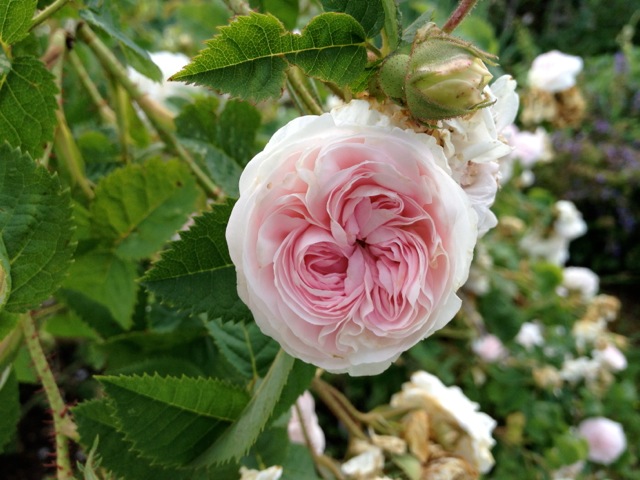
Belonging to Places
Director’s Notes” are excerpts from our monthly email newsletter, “Stories from the Garden.” Subscribe and see past issues here.
Dear Friends,
I am sitting in W.S. Merwin’s rose garden in southwest France as I begin this letter. I’ve arrived late, but days here in June stretch out long, and I’m in time for an evening spectacle. A glow fills the valley below, to the north across the Dordogne river. On a hilltop in the distance, an 11th century castle burns a fiery red in the slanted light. Closer in, jumbled rooflines rise from villages that have changed little over hundreds of years. Just below, sheep pastures and walnut groves.
A few days into my visit, I’ve explored the pockets of this place several times over: the small house that William restored from ruins, just to the east outside the garden’s stone walls; beyond that the bakehouse where he made his study, two barns and an old pigeonnier. And after gazing out windows across this timeless landscape, I come to see that I’ve misunderstood William’s connection to this place. Until now, I’ve thought of it as what came before—before the Peʻahi house and the palm garden I’ve come to know so well. William found this house in 1954, in his late twenties. In the 60s, sitting with the ills of the world in the old bakehouse, he wrote The Lice. And then, in the late 70s, he made his way to another river valley, this one on Maui. As he writes in “The House and Garden: The Emergence of a Dream” of his early years here in the Midi-Pyrénées:
Whatever I may have learned there, along with the love of a place—not merely a piece of property—was part of me when I looked out across the valley of Peʻahi Stream years later.
But having settled in here, catching glimpses of early and late poems in the shadows of walnut trees, in stone walls and racing along the tiles, and encountering objects that moved with William and Paula across oceans and miles and decades, I have come to understand the relationship between these places not as sequenced in time, but as fluid—formative and enduring, evolving and deepening over ruptures and returns. William writes of his home in France, again in “The Emergence of a Dream”:
My life there, for large parts of the year over many years, was a lifetime education to me and was formative in my feelings about living, if not exactly in the woods, in a completely rural place that was rooted in tradition, and to live there as someone who belonged there.
These two gardens, two houses, perhaps the two places to which William most deeply belonged, are of course quite distinct. Roses and vistas here, palms and dense canopies there; this house found in ruins, untangled from blackberry brambles and revived, that one imagined and then brought to life by hand. But despite distinction and distance, they share a root system of clear convictions, steadfast care, and belonging. Both are alive, nourished by an abiding desire to put life back into the world. I see now that they have always been and remain in dialogue. In the rose garden, hanging from a thorny branch, I find an aluminum tag just like the ones William inscribed and coiled around palm stems in Hawaiʻi. In the bakehouse study, I find a photo of the Peʻahi house on the desk, leaning up against the windows. I call to mind the small sketch of this house hanging on the wall in William’s study among the palms.
I am back on Maui with a deepened sense of what it means to belong to a place—to places. I see new traces of that belonging in the palm garden, and in the Peʻahi house. For me, now, to belong to a place is to be utterly present there, and to hold this presence across time through participation in its evolution and well-being, and by extension, in the evolution and well-being of the world.
With warmest regards,
Sonnet